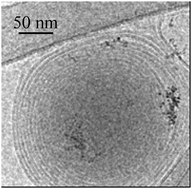Multilamellar liposomes entrapping aminosilane-modified maghemite nanoparticles: “magnetonions”
Abstract
4.6 nm-sized

* Corresponding authors
a
CNRS, UPR 8641, Centre de Recherche Paul Pascal (CRPP), 115 avenue du Dr Albert Schweitzer, Pessac, France
E-mail:
faure@crpp-bordeaux.cnrs.fr
Fax: 33 05 5684 5600
Tel: 33 05 5684 5665
b Université de Bordeaux, UPR 8641, Pessac, France
c CNRS, Université de Bordeaux, ICMCB, 87 Ave Dr A. Schweitzer, 33608 Pessac Cedex, France
d Université Bordeaux 2, Victor Ségalen, 146 rue Léo-Saignat, 33076 Bordeaux Cedex, France
e CBMN UMR-CNRS 5248, Université Bordeaux, ENITAB, IECB, Avenue des Facultés, F-33405 Talence, France
4.6 nm-sized

 Please wait while we load your content...
Something went wrong. Try again?
Please wait while we load your content...
Something went wrong. Try again?
M. Meyre, R. Clérac, S. Mornet, E. Duguet, F. Dole, F. Nallet, O. Lambert, S. Trépout and C. Faure, Phys. Chem. Chem. Phys., 2010, 12, 12794 DOI: 10.1039/C0CP00231C
To request permission to reproduce material from this article, please go to the Copyright Clearance Center request page.
If you are an author contributing to an RSC publication, you do not need to request permission provided correct acknowledgement is given.
If you are the author of this article, you do not need to request permission to reproduce figures and diagrams provided correct acknowledgement is given. If you want to reproduce the whole article in a third-party publication (excluding your thesis/dissertation for which permission is not required) please go to the Copyright Clearance Center request page.
Read more about how to correctly acknowledge RSC content.
 Fetching data from CrossRef.
Fetching data from CrossRef.
This may take some time to load.
Loading related content
